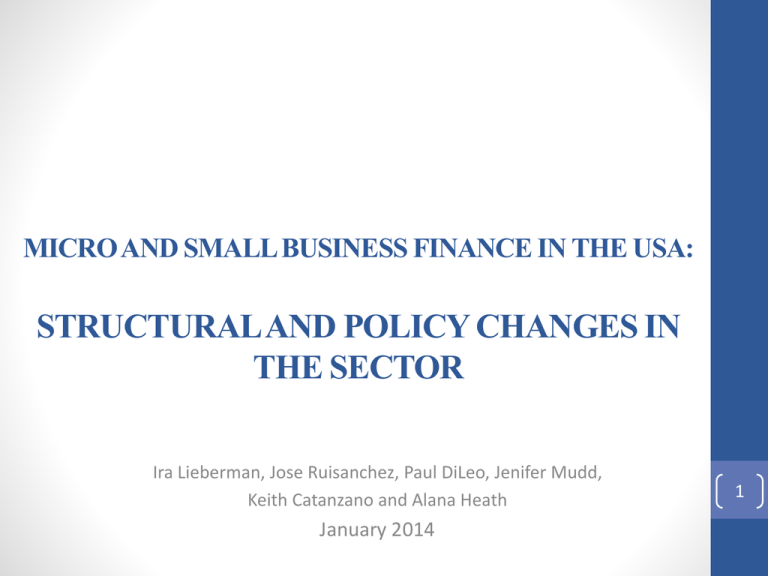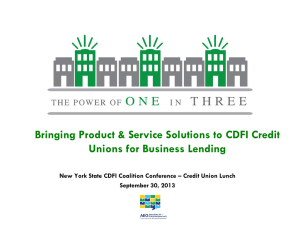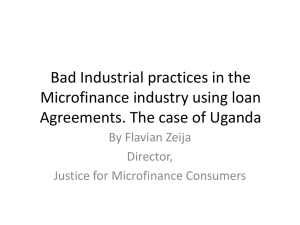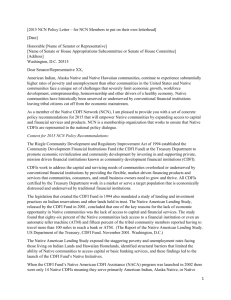Summary-for-website - Grassroots Capital Management
advertisement

MICRO AND SMALL BUSINESS FINANCE IN THE USA: STRUCTURAL AND POLICY CHANGES IN THE SECTOR Ira Lieberman, Jose Ruisanchez, Paul DiLeo, Jenifer Mudd, Keith Catanzano and Alana Heath January 2014 1 Introduction The American Dream is out of reach for millions of Main Street and micro business owners. Yet there is cause for optimism: Technology is making it possible for new providers to deliver capital to Main Street in new ways. Automated credit decisions that aggregate and analyze a wide array of contextual data as well as peer-to-peer lending and its corollary, crowd-funding, are fast becoming the norm. In parallel, post-crisis performance pressures mounting within the traditional worlds of banking, community development finance and philanthropy are pushing leaders in each discipline to explore new models for investment and capital formation as well as product distribution and development. Against this backdrop, AEO, the national trade association for US microfinance, asked Ira Lieberman, one of the pioneers in enabling microfinance to scale internationally, to assemble a team of experts to answer the question, “What investments in infrastructure and capacity are required to ensure that mission-focused lenders and service providers remain relevant and achieve sustainability in the United States?” This team of six included two people from Grassroots Capital Management; Paul DiLeo and Alana Heath. At the same time, the Micro Capital Task Force (MCTF) was initiated to engage a systematic and coordinated effort to bridge the emerging and established elements of the U.S. financial system in order to solve the gap in loans <$250K. The MCTF represents all of the stakeholder groups that must engage to advise Treasury and the White House. 2 Primary Objectives of the Strategy 1) Provoke micro and small “Main Street” business growth and new jobs 2) Support underserved populations 3) Generate a culture where access to finance is more readily available at sustainable interest rates 3 Observations Micro and small businesses represent over 90% of business establishments and are responsible for over 25 million direct jobs in the U.S.A. These firms which we define as Main Street Business, are often called family or life style businesses in that they are the primary source of income for the family unit and help ensure that the family is fed, clothed, and that the children are educated. Many of these businesses, especially those operating in poor communities, those owned and operated by women or immigrants (such as in the Latino community), those recently retired or forced to retire due to the recent recession, or by returning veterans, find it difficult to access capital other than from family and friends. Those institutions providing funding and business advisory services to the sector include community development finance funds (CDFIs) which are mostly NGOs, credit unions and community banks; for a variety of reasons these institutions have had difficulty scaling-up to meet the perceived demand in the sector. We estimate unmet demand at between $44 and $52 billion in unmet demand annually.The CDFI funds as not-for-profits are generally not sustainable and have high costs due to their business models and interest rates which fail to cover their operating costs. For CDFIs to be relevant they will need to charge interest rates consistent with the sustainability of an efficient operation. At present these institutions are highly reliant on subsidized funding from a variety of sources. Credit unions and community banks operate as for profit institutions subject to supervision. While return on assets may be low for CDFI credit unions, if they are not profitable and don’t maintain minimum capital levels they are subject to intervention by their supervisors. Community banks are similarly regulated. CDFIs raise funds from a variety of sources including several funds under the direction of the U.S. Treasury¹, from the Small Business Administration (SBA), the Department of Agriculture, foundations and commercial banks and their foundations, primarily funding under CRA requirements. Historically there has been little private capital in the sector. CDFIs, particularly the not-for profit funds, spend a great deal of their time raising capital. Both community development banks and credit unions raise deposits as their primary source of funding. Some Low Income Credit Funds raise funds from the Treasury’s CDFI Fund. Recently, Community Banks have raised funds from the SBA’s Community Advantage facility. ¹Historically these funds have come from the CDFI Loan Fund. But due to the 2010 Jobs Act passed by the Congress, the Treasury in recent years has provided funds to states in an amount of $1.5 billion from the SSBCI which is then down-streamed to various funding institutions and the Small Business Loan Fund (SBLF) in an amount of $4.0 billion primarily for community banks but also a select number of CDFIs. 4 Observations In the last several years, for-profit lenders have entered the sector using internet technology and data mining techniques and have been able to scale their operations rapidly. These relatively young firms have invested heavily in technology and their initial cost of operations are high, particularly the cost of client acquisition. Hence they are required to charge high interest costs to breakeven or generate a modest profit. But with scale and time their costs will come down, they will be able to charge lower interest rates and they will be profitable and valuable to meeting the needs of Main Street business. A logical way to scale up the provision of finance from the sector to Main Street Business is the linkage of technology players with CDFIs. It is not feasible for each CDFI to develop its own technology platform. Some initial efforts to create such linkages are underway, however much more needs to be done. There is little in overall data on financing by the sector to Main Street business as the CDFI Fund, the SBA, Department of Agriculture each require beneficiaries to report; the SBA on a loan by loan basis, but each institution maintains their own data bases with little by way of analysis available to the industry or the public. For profit lenders are privately held and do not provide information on their sources of finance or their loans. There is an urgent need for a centralized source of information on funding to Main Street Business, as opposed to the fragmented data bases currently available. Business development services (BDS) are perceived as valuable to improving the performance of Main Street Business. There are many such BDS providers, primarily as not-for-profit institutions relying on grant funding. Many of the CDFIs offer BDS to their clients but this increases their cost of operations, as there is little in the way of cost recovery. There is also little in the way of metrics and more can be done to provide sources of BDS good practice programs from a central depository ( cloud based) or data base. Again technology and the use of the internet, including the provision of on-line distant learning courses, could be valuable. Linking BDS providers to a network of CDFIs and high technology providers would complete the loop in scaling up support to Main Street Business. There is a need for a shift in strategy by funders and lenders to institutions providing access to credit for Main Street Business. Our recommendations propose an integrated / coordinated change in strategy. 5 Target Clients: Micro and Small “Main Street” Businesses • Micro and small “Main Street” businesses account for the vast majority of small business operators in the USA • Micro is defined as 0-4 employees and small business 5-20 employees • But number of employees in itself does not tell us very much—who are the target clients? - a diverse array of private business operators: Merchants/ retailers Restaurants Street vendors Self-employed people often working from home Service establishments of all kinds Small scale farmers Food processors • Focus on poorer regions of the country (both urban and rural) and on disadvantaged populations: minorities (recent immigrants, Latinos and Asians, African Americans), women, veterans, people over 50 years of age forced into retirement or laid off and looking for a means to support themselves and their families -- all adversely affected by the recent economic downturn • These are often called “life style” or “family businesses” that may employ members of the family, often not compensated, and rely on the business’ surplus to feed, clothe, provide health care to the family and to educate the children • Not focused on hi-tech start-ups such as internet, IT or biotech operators who seek seed capital and eventually venture capital to grow • Need to be very clear who target clients are 6 Provision of Financing & Services to Main Street Businesses: Core Institutions 7 Types of Core Institutions Who are the institutions? • Community Development Finance Institution Loan Funds (CDFI Loan Funds): NGOs that provide microfinance, small business finance, business development services, and other services to Main Street businesses—often described as mission driven • Credit Unions: Low Income Credit Unions (LICUs), CDFI Credit Unions (CDFICUs), and Community Development Credit Unions (CDCUs) • Community Development Banks (CDBs): important source of small business loans for Main Street • Emerging For-Profit Financial Institutions: growing number of diverse, nonbank, non-regulated institutions, whose focus is on internet and large data mining. Together form a “disruptive technology” that is changing the sector 8 Continued: Types of Core Institutions • There are also other institutions Money lenders: primarily consumer focused pay day lenders, check cashiers, tax advances— not discussed herein Established large-scale institutions that are major players-not discussed herein— AMEX, Pay Pal, Regional Banks, Commercial Banks offering credit cards (still the major source of micro and small business loans), merchant advance and small business loans • Business Development Service (BDS) Providers: Microenterprise Development Organizations (MDOs) that provide advisory services only and CDFIs Overall this is a large, diverse set of institutions • The impact of which is hard to assess and measure particularly with respect to minority and immigrant communities who primarily run family style businesses – defined as supporting the basic needs of the family unit 9 Core Institutions: What Constitutes Success? • Reaching scale in provision of financial and service support to micro and small Main Street Business • Reaching higher levels of financial sustainability, thereby reducing rate of subsidy 10 Interest Rate Culture In June 2011, FIELD published a funder’s guide to pricing, which highlighted a number of key findings addressing issues of pricing: • Most, if not all, non-profit microlenders in the United States are charging prices that are subsidized and, therefore, do not cover the costs of their microlending programs. • There is no industry-wide data on the prices charged by non-profit lenders, although participants in the Scale Academy reported charging rates between 5% and 18%. • In comparison, as of April 2011, for individuals with subprime credit, the average credit card interest rate was 23.95%, the national average credit card interest rate was 14.67%, and the average rate for business credit cards was 12.91%. • Rates offered by several for-profit microfinance organizations to microentrepreneurs vary broadly, ranging from 18% to 60%. The average rate for several technology lenders appears to be 40% with an average loan size of $35k. • Funding sources play a critical role in pricing, with public sector funders appearing to be the most likely to specify the interest rates and fees that can be charged on loans made with the capital they provide. • MDO staff members often believe borrowers will be resistant to higher pricing, although microlenders have done very little market research to test borrower perceptions. • Some market surveys point to the willingness of potential customers to pay significantly higher prices if they can access financing in days rather than weeks. • There is growing recognition that charging below-market interest rates may be one factor hindering the growth and sustainability of non-profit microlenders. Source: Lieberman et. al. Microfinance at the Crossroads. 2012 11 Characteristics of Core Institutions CDFI Loan Funds (NGOs) • Provision of finance, BDS and other services to Main Street businesses • None have commercialized, small scale • Average U.S. loan size approximately US$14,000 • Community-focused though some have extended their geographic reach; only two networks have a diverse geographic reach: Accion and Grameen • Complex business models offering a variety of financing products and services • High cost of operations • Low interest rates that fail to cover cost of operations • Highly dependent on subsidies • Obtain financing and grant support from a variety of sources— U.S. Treasury CDFI Fund, SBA, USDA, states, municipalities, commercial banks fulfilling CRA requirements, foundations • Data on their performance and impact partially available from a variety of sources, but is fragmentary or incomplete as a time series and with respect to information on the institutions’ financial status or impact 12 Business Development Service Providers • What are Business Development Services (BDS)? BDS are non-financial services for entrepreneurs (Main Street business persons) BDS include training courses, one-on-one mentoring, advice, assistance with operations and business incubation BDS topics span financial literacy, entrepreneurship, business plans, management practices, marketing, bookkeeping, technology/IT, legal & tax, linkages with other businesses, how to get a loan, etc. BDS aim at helping an entrepreneur start a business, or at improving the performance of a business, and may prepare businesses to qualify for financing. • Who are BDS Providers? BDS are provided by over 800 Microenterprise Development Organizations (MDOs), as well as USDA intermediaries While many of those MDOs also make loans (CDFIs), some providers focus exclusively on BDS (no loans) In addition, government entities (SBA, state, local) provide or support BDS Universities and businesses also provide or support BDS BDS providers which are MDOs are mostly dependent on grant financing 13 NOTE: The MicroTracker website in FIELD at the Aspen Institute contains information on BDS provided by Microenterprise Development Organizations. For FY2012, there were 216 MDOs reporting the provision of BDS to over 48,000 businesses and 117,800 individuals. The total number of business and individuals receiving some sort of BDS was likely a significant multiple of the MDO figures. Continued: Business Development Service Providers • Delivery Traditionally, directly through in-person classes and meetings Increasingly, remotely through the Internet and on-line meetings About 111,000 persons received BDS from MDOs in 2010 (FIELD Study) No data on the many persons receiving BDS from non-MDO providers • Challenges No industry estimates on the effectiveness of BDS No data on the demand for BDS Most BDS providers lack scale BDS providers rely on grants to cover their budgets CDFI self-sufficiency often suffers when provision of BDS added as product in addition to loans Many BDS providers develop their own training materials NOTE: BDS providers which are MDOs are usually small; FIELD’s MicroTracker reports their median staff size in FY2012 at 3 full time employees. Providing quality training and advice is expensive; technology is helping BDS providers become more efficient. 14 Mobilizing Capital 15 Main Street Lending in the U.S. Funding Sources Public Loans / Deposits CDFI Fund SBA Loan Fund Providers Clients MDOs CDFI Loan Funds Fed/State/Local Govs. Private Credit Unions: LICUs, CDCUs, CDFI CUs Banks (CRA) Community Dev. Banks Microentrepreneurs Depositors Foundations Emerging For-Profits Capital Mkt. Investors Credit Cards, HELOCs Grants Public & Private CDFI Fund, SBA, Fed/State/Local Govs. Bank & Private Foundations Pay Day Lenders Small Businesses loans to microentrepreneurs loans to small businesses technical assistance & training Source: Lieberman, Ira, Phil Goodeve and Jenifer Mudd. U.S. MICROFINANCE AT THE CROSSROADS: Scale and sustainability: can lessons from international experience help guide the U.S. sector? September 2012 16 Overview of Current Sources of Funding for Main Street Lenders and BDS Providers • Government: Treasury, SBA, USDA, State and Local provide significant concessional and long term funding but flows are unpredictable from year to year and conditions can be complex. • Large Commercial Banks and their foundations provide significant grants and capital driven largely by CRA requirements. • Non-Bank Foundation’s support to the sector has diminished in the face of mixed results and unstable models. • Public Insured Deposits are important for regulated institutions such as LICUs and CDFI banks, but are constrained by limited equity. • Privately Managed Intermediaries’ engagement is sporadic, discouraged by poor data and “crowding out” by government programs. 17 Commentary on Funding for Main Street Lenders In 1997, international microfinance institutions (MFIs) were estimated to be reaching 13mm clients with loans and other services designed to help the poor escape from poverty. This represented an insignificant fraction of the hundreds of millions of families living in poverty around the world, and a campaign was launched with the audacious goal of reaching 100mm clients with microcredit by 2005. That goal was more than met and the most recent estimates are that microfinance is reaching 200mm families representing over 600mm people. While there are many ways in which most of the countries where microfinance has taken root differ from the U.S., the common perception that the differences were so great that there is little or nothing of relevance to the U.S. in the international experience is misleading. Throughout this period of rapid growth, international MFIs have faced intense competition from other for-profit but not mission driven institutions, including commercial banks, non-bank lenders. They have confronted major structural shifts – urbanization, rapid growth in incomes and formal sector employment, and technological developments like mobile banking and big data. They have lived through dramatic macroeconomic cycles and political instability, and regulatory change and uncertainty. Indeed we have concluded that despite all the differences much of what MFIs grappled with internationally is quite relevant to the U.S. and that the key choices made in the successful microfinance campaign are directly applicable to the U.S. Key among them was the commitment to achieving scale notwithstanding the often painful choices that this required, among them placing a premium on efficiency and on financial sustainability, and implementing the necessary changes in organizational culture and staffing. The commitment to scale was first and foremost a decision to be relevant given the magnitude of the problem of global poverty. But it also set in train a virtuous cycle of improving efficiency, widening access to financial resources, and engagement of new types of leaders and managers who introduced innovative and often disruptive advances in processes and technology. While the push for scale has required constant vigilance to prevent the loss of the fundamental social character of microfinance, it has also enabled significant advances, all of which are sorely needed in the US community development finance industry as well, and specifically in small and micro business lending: greater responsiveness to clients; efficiency gains consistent with declining but still profitable interest rates; access to a wide array and greater volume of capital; introduction of sophisticated risk management; better data and research on impact. 18 Commentary on Funding for Main Street Lenders An important element of the scale campaign was the deliberate creation of specialized investment managers and “microfinance investment vehicles” (MIVs). The first such dedicated vehicle was launched in 1995 with $20mm from foundations and governments. Today there are over 120 MIVs with nearly $7 billion under management, the bulk from private investors. These vehicles serve several purposes: • Shifting the focus from annual program based funding to medium and long term institution building; • Permitting the most efficient use of different types of capital from different investors, for example by leveraging government or foundation first loss grant funding; • Building professional governance of institutions to support and supervise management in implementing growth plans while remaining true to mission; • Creating demand and a market for better performance data, both financial and social; • Access to sophisticated financial engineering to optimize balance sheets and reconcile needs of investors and institutions; • Accelerating the diffusion of lessons learned and best practice; • Helping manage investment risk by pooling investments in diversified portfolios; and • Telling the “microfinance story” to the emerging enthusiastic but inchoate community of impact investors. 19 Commentary on Funding for Main Street Lenders Each segment of the US community development finance industry can benefit from some or all of these influences of a specialized and dedicated investment management capability can provide. Specifically: CDFI banks need the reliable access to equity to fund steady balance sheet growth and strengthened governance; Credit unions need secondary capital; Loan funds need to improve leverage and efficiently utilize grant and first loss capital to mobilize more risk averse funding and pilot and penetrate new markets and products. The international experience shows that a dynamic investment fund community helps accelerate the deepening and strengthening of the infrastructure supporting the development finance industry. 20 Professionally managed private investment leverages government capital and drives rapid performance improvements. • International microfinance found that combining private capital investment philanthropic and government funding through capital pools or co-investment increases total capital inflows, drives performance improvements and accelerates adoption of new lending and service models: Able to tap a full range of funding sources, and devote the scarcest grant capital to its highest and best use. Encourages management to adopt solid business practices and ensure long term viability in the mix of products and services offered. Provides for rigorous governance and brings a wider range of expertise to support and guide management. • As has been seen in international microfinance, the investment model is not without risks: Broadening the pool of investors can undermine the cohesion enjoyed by a more homogenous group of funders. The “brand” can be at risk of being hijacked by opportunists who do not share the social mission. “Mission drift” if commercial considerations assume preponderant weight. • But the risks of failing to adapt the model are great as well: Sub scale, leaving most potential clients to less scrupulous operators. A different type of mission drift, as intermediaries have to chase fickle grant and program dollars each year. Erratic funding undermines ability to provide reliable support to clients and communities over the long term. 21 Key Functions of Main Street Lender Investment Vehicles 1. Raise Capital: Educate investors about the opportunity Create pooled vehicles that offer diversification of risk Offer structured vehicles that match different financial return / social return / risk appetites Combine capital from public, philanthropic and private sources in structured vehicles to take best advantage of the capabilities of each source 2. Build MSLIV Balance Sheets: Provide Main Street lenders with instruments best suited to optimize their balance sheet structure: equity or quasi equity to absorb risk, subordinated or senior debt to provide leverage. 3. Support Management: Nurture managers of early stage vehicles Provide diverse and increasingly sophisticated expertise to more mature and growing companies Promote knowledge sharing and best practice 4. Strengthen Governance: Help build engaged and committed boards and staff board committees with appropriate expertise. 5. Build Liquidity: Continuously build the pool of investors to provide liquidity necessary to ensure reliable access to capital as needed. 22 Continued: Key Functions of Main Street Lender Investment Vehicles and Managers Building a dynamic MSLIV industry to supply capital and other critical support to lenders requires multiple components: Managers • Manager expertise in the full range of debt and equity instruments and financial intermediary analysis, and the challenges of investing in social mission. • Managers with demonstrated track record of raising capital, investor relations, investing and returning capital. Anchor Investors • Anchor investors who can provide a foundation for fundraising and help absorb costs while vehicles are sub-scale. Low Cost / Pro Bono Support Services • • • • • Legal Accounting Custodial Administrators Tax and Reg advisory 23 By the Numbers: a Data Analysis of Community Lending Industry 24 Discussion Except for CDFI banks, 80% of CDFI institutions (e.g., CDFI loan funds, CDFI credit unions) have assets under $100 million; 70% of CDFI banks have assets over $100 million. It is therefore not surprising that much of the lending within the CDFI industry comes from banks. CDFI banks originated $2 billion in C&I loans as of 3Q2013. In comparison CDFI loan funds, anecdotally, originate between $100 million to $300 million in small business loans per year. The CDFI industry is mission-driven. This is evident in the nature of small business borrowers it reaches. A 2008 University of North Carolina study identified that 83% of CDFI loans focus on areas with low or very low income and 45% of CDFI loans focus on areas with high minority population. As an example Accion-Texas’ clients are 72% minorities and 40% women. Compared to the approximately 7000 total banks and thrifts in the United States, CDFI banks represent a small fraction of the overall banking industry’s small business lending. According to US Treasury's Call Reports, in 2012 there was $120 billion in outstanding C&I loans for under $100,000 and $46 billion in outstanding C&I loans for between $100,000 and $250,000. Most of the overall SB lending by banks, thrifts and holding companies, however, consists of credit card balances. Within the Call Reports the average balance of loans under $100,000 for 2012 was under $6,000. In contrast, where banks accessed explicit small business lending programs, average loan amounts are more indicative of term loans (e.g., average loan size of $27,345 for loans under $100,000). By modeling these loan amounts and small business owners' access to capital, as captured in the D&B/Pepperdine Capital Access index, we are able to separate banks' small business lending from credit cards balances. Our initial modeling suggests that banks provide approximately $15 billion to businesses with under $5 million in annual revenue. Our modeling suggests banks lend $3 billion to businesses with under $500,000 in annual revenue. It is not clear how much of this lending is accessed by minorities and women. There is an opportunity for future studies to drill deeper into the survey data to characterize minority and women's accessibility to capital from the banking industry. While depository lenders are an important source of capital, over the past several years a relatively new industry of technology-intensive, alternative lenders has emerged. This industry provides working capital to small businesses. The Wall Street Journal estimates the size of this industry in 2013 was approximately $3 billion dollars. The typical borrower is a business that has existed for several years and has over $1 million in annual revenue. 25 Observations Combining these three sources (CDFI banks and loan funds, alternative lenders, and non-credit card bank loans) captures $20+ billion of comparable small business lending and allows us to make some preliminary comparisons across the providers. (This does not include funding from friends & family, grants, crowd-funding, trade credit, credit cards, leases, asset-based lenders, factors, angel, venture, PE, Mezzanine debt or Hedge funds.) • These loans are similar in that they are in the $20,000 to $50,000 range. In particular the CDFI and alternative lender loan amounts are very comparable in size. • Bank and CDFI loans have lower rates than alternative lenders, but alternative lenders offer faster and more convenient access to capital. • CDFI and alternative lenders both provide an alternative to banks with products for small business borrowers with sub-680 FICO scores. • CDFI’s deliberately support minority and women business owners. While we were unable to examine the characteristics of borrowers from alternative lenders and the banking industry, writ large, Biz2Credit's small business lending index identified that small business loan approval rates across all loan providers are 15-20% lower for women-owned companies. • Approval rates are significantly different. Biz2Credit's lending index identified approval rates for big banks as approximately 15%, small banks as approximately 50% and alternative lenders as approximately 63% (CDFIs were not explicitly covered). 26 This analysis of multiple data sources roughly characterizes small business lending. • Most publically available data focuses on the supply of capital rather than the demand. • There are few public records of the borrowers – the CDFI loan database represents a characterization of borrowers by comparing to census track data. • There is little public information about overall alternative lending market size and their borrowers – therefore this analysis emphasizes interview data. • This analysis focuses on commercial and industrial loans under $100,000. These loan products are assumed to be for micro and “main street” businesses. 27 Conclusions from the Project 28 Conclusions • Who is the Industry Serving and Why Micro and small businesses represent over 90% of business establishments in the U.S. A vibrant micro and small business community is critical for disadvantaged populations and communities Critical for dynamic job growth and for closing the wealth gap More robust infrastructure support for Main Street businesses, including financing and business development services, can significantly improve the prospects of the disadvantaged • Large Unmet Funding Gap Though there is inadequate industry data, the use of credit cards, the emergence of merchant advance lenders, predatory money lenders and other newly emerging for-profit lenders, suggests that there is a large unmet need • Inadequate Industry Data There is no ability to determine on an industry-wide basis whether funds in the sector flow to deep seated areas of poverty or disadvantaged populations No comprehensive database for the industry To engage larger and more diverse funding sources significant improvements in industry data are required 29 Conclusions • Community Development Financial Institutions Loan Funds as NGOs focused on microfinance and small business with very few exceptions have: 1) Failed to scale to meet demand 2) Have complex business models 3) Are too costly to operate without substantial subsidy. As structured the sector falls short of the need. Credit Unions have significant potential to serve micro and small business, but are essentially focused on other loan products. Community Development Banks have substantial potential to serve Main Street business and are receiving substantial funding from the Treasury through SBLF There is an urgent need for structural and policy reform in the sector. 30 Conclusions • For-Profit lenders are leading the way in technology and data mining to promote scale There are a number of for-profit, privately owned financial intermediaries, that are addressing the needs of the micro and small business sector They are focused on scale-outreach, agility, quick response to credit requests, and profitability via a variety of models and interest rates that vary greatly This is “disruptive” technology and a few private for-profit lenders have already eclipsed CDFI Loan Fund scale A few CDFI Loan Funds are beginning to awaken to the potential of technology to change their model and improve efficiency Without technology adoption by a network of CDFIs (and it cannot be done CDFIby-CDFI) the CDFI micro credit industry will increasingly lose relevance 31 Conclusions • Business Development Services BDS plays a critical role in the promotion of small and micro business BDS data is inadequate and provides little evidence of impact There are no generally accepted metrics There is significant duplication in preparing BDS materials While recognizing the importance of “high touch” community presence there is substantial scope for utilizing standardized materials facilitated by technology Potential to enhance efficiency and productiveness by partnering with financial institutions • Interest Rate Culture For CDFI Loan Funds to be relevant, they have to charge interest rates consistent with sustainability of an efficient operation A deep seated culture of subsidized rates is impeding the industry Cost recovery interest rates are not incompatible with social mission 32










